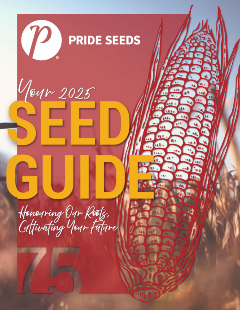___________________________________________________________________________________________________________________________________________

2024-2025 PRIDE Seeds Product GuideYou can find all of our products on the website, including supporting performance data and create your own personalized guide called My Guide. You can also download the digital version of our printed product guide which includes product comparison charts. |
Evaluating Plant Emergence
In any given weather condition, understanding and evaluating corn emergence is critical. This newsletter will explain reasons for poor emergence and how we can try to avoid it and track it in spring.
WHY IS EMERGENCE IN CORN SO IMPORTANT?
Simply put, corn is a poor competitor with other corn plants (weeds too, but we will leave that topic for another day). Plants that emerge within 48 hours of each other are close enough in staging and development that they will not compete very much, if any, against each other. The problem happens when plants emerge outside of that 48-hour time frame. These late emerging plants tend to lag in staging and development compared to the plants that emerged in a timely fashion. Competition from the larger, first emerging plants reduces the yield of the smaller, late emerging plants.
REASONS FOR POOR OR UNEVEN EMERGENCE
- Lack of Soil Moisture or Soil Moisture Variability
- Water is critical for germination, without water germination can not happen. Lack of soil moisture or uneven moisture at the planting depth can occur throughout the field due to soil variability. Seeds planted into dry soils will wait to germinate until after a rainfall event occurs. Light rainfall events following planting into a dry seedbed can cause uneven germination leading to uneven emergence.
- Uneven Soil Temperature or Cold Temperatures
- Fields with heavy residue or heavy residue pockets throughout the field can have uneven soil temperatures – cooler soil temperatures in the areas with heavy residue.
- Cold soil temperatures usually means cold soil water. When the seed imbibes cold soil moisture, it’s like a “shock to the system” and can result in imbibitional chilling injury or a corkscrewing effect of the mesocotyl depending on when the cold temperatures are experienced by the seed.
- Soil Crusting
- Crusted soil surfaces can restrict the emergence of the coleoptile and can result in the seedling leafing out underground.
- Disease Injury
- Seedling blights and root rots are the diseases that are commonly observed at this point in the season. Seed treatments offer protection against blights and root rots, but they only last so long.
- Planting Depth or Uneven Planting Depth
- Target 2” (1.5” to 2.5”) planting depth for corn. Emergence problems tend to arise when corn seed is planted deeper than 2.5” (colder soils, moisture may be less uniform, etc.).
- Insect Injury
- Wireworms and seed corn maggots are common insect pests that can feed on seeds in furrow and cause damage that results in reduced emergence. PRIDE Seeds corn hybrid seed is treated with an insecticide (Fortenza(R)), but infields/areas with high insect pressure, seed treatments can only do so much.
- Herbicide Injury
- This is when reviewing herbicide records of the field can be extremely helpful. Using records, you should be able to find out to what extent the herbicide damage is and make the appropriate decisions. There are often other factors contributing to herbicide injury (poor rainfall, low soil moisture, cold temperatures) in corn during emergence, but not always.
AVOIDING UNEVEN EMERGENCE
- Use Tillage When Appropriate
- Avoid excess tillage which can dry out or compact the seed bed
- Tilling wet soils can result in clumpy soils that can cause poor planter performance (uneven spacing within the row and/or uneven depth)
- Monitor Seed Placement During Planting
- Check on the seed to soil contact and depth uniformity
- Make adjustments to the planter accordingly
- Check the Soil Temperature
- 10C is the soil temperature you’re looking for before planting your corn
- When temperatures are below 10C, there is an increased risk of cold injury which can result in failed emergence or poor plant vigour once emerged
- Check planter performance
- You may have uneven emergence in your field because your planter was not properly set or calibrated
- Check that the planter is level, ensuring even depth on each row unit and use the appropriate planter downforce
TARGET 80% OF PLANTS EMERGING WITHIN 48 HRS
80% of plant emergence within 48 hours of each other (higher percentage within a shorter time period is better) is a good target to aim for. If you’re missing this target, hopefully this newsletter can help you find out why.
HOW TO CHECK EMERGENCE: FLAG TEST
You will need 5 different coloured flags or stakes to mark out 1/1000th of an acre and 4 days of plant emergence 1. Flag out 1/1000th acre prior to emergence but after planting (Colour #1) 2. Check 1/1000th section everyday at the same time 3. Once plants emerge within the 1/1000th flagged section, use a different colour flag to mark newly emerged plants (Colour #2) 4. Repeat this for the next 3 days (Colour #3-5) 5. Determine emergence rate and planting population.
THE PRIDE SEEDS ADVANTAGE
Farming is one of the most demanding industries in the world, subject to a variety of factors such as time, weather, and global pressures. You know this every time you look out the window and think about the field in front of you. Growers and dealers deserve an advantage: The PRIDE Seed Advantage.
LEARN MORETHE PRIDE SEEDS ADVANTAGE
Every year PRIDE Seeds works hard to produce leading-edge products that enable success where it matters most, on your farm. Our dedicated team strives to provide sales expertise, agronomy support, quality production, and service tailored to meet your needs.
LEARN MORE
-7.png?sfvrsn=87920db3_3)

Leave a commentOrder by
Newest on top Oldest on top